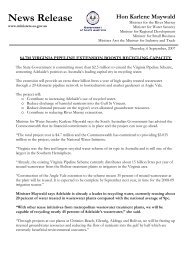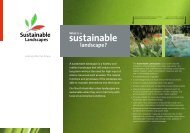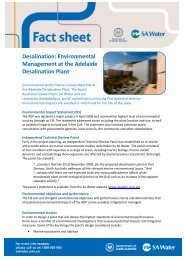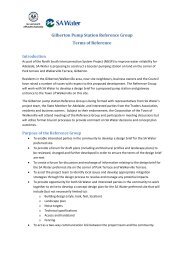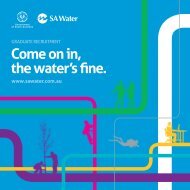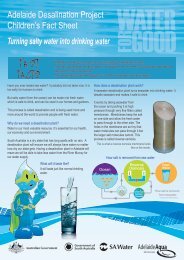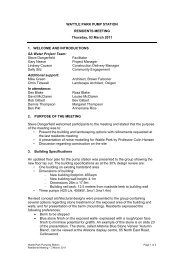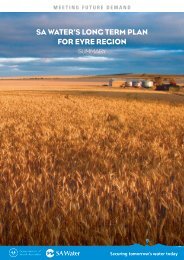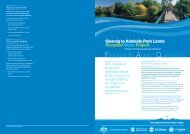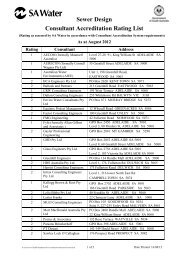Code of Practice - Irrigated Public Open Space - SA Water
Code of Practice - Irrigated Public Open Space - SA Water
Code of Practice - Irrigated Public Open Space - SA Water
You also want an ePaper? Increase the reach of your titles
YUMPU automatically turns print PDFs into web optimized ePapers that Google loves.
5.4 Plant/turf species selection<br />
Warm season turf grasses (Kikuyu or Couch) use 30 – 50%<br />
less water than cool season turf grasses, (Fescues or Ryes).<br />
The drought tolerance <strong>of</strong> warm season grasses is significantly<br />
higher than the cool season grasses. Turf species should be<br />
selected to meet the functional objective while minimising<br />
water use.<br />
Warm season turf grasses (Kikuyu or Couch) should be<br />
used as the predominant turf grassspeciesforirrigated<br />
public open space in South Australian conditions.<br />
Where turf is subject to intensive winter activity such as<br />
football, over sowing in autumn with a cool season turf<br />
species such as a transitional rye grass will improve<br />
wearability and recovery <strong>of</strong> the turf during the cooler months<br />
without requiring additional water over the summer period.<br />
5.5 Turf quality/‘fit for purpose’<br />
Turf should be maintained to meet quality and risk<br />
management standards appropriate for its intended use.<br />
Sporting club associations and ground managers have a<br />
duty <strong>of</strong> care to all people using facilities. This means that<br />
sports facilities, including turf surface, must not present an<br />
unacceptable risk <strong>of</strong> injury to those using the facilities.<br />
Passive irrigated areas require a lower standard and have<br />
lower risk ratings than active sports grounds. The standard<br />
to which turf is maintained has significant impact on water<br />
usage. Turf must be maintained at a level that ensures safety<br />
for users and meets the functional objective. A passive<br />
irrigated area can be maintained using up to 50% less water<br />
than an active sportsground.<br />
5.0 TURF & IRRIGATION MANAGEMENT PRINCIPLES<br />
14<br />
<strong>Irrigated</strong> turf areas should be classified according to the<br />
intended function and the ‘fit for purpose’ standard. Turf<br />
can be rated according to the Turf Quality Visual Standard<br />
(TQVS) classifications as detailed in Table No 1.<br />
Turf quality and risk management standards should be<br />
developed and include the following criteria:<br />
• Turf Quality Visual Standards (TQVS) indicating<br />
‘fit for use’ turf standards.<br />
• Turf grass vigour and density.<br />
• Evenness <strong>of</strong> turf surface.<br />
• Cutting height <strong>of</strong> turf.<br />
• Presence <strong>of</strong> weed species or pest infestation.<br />
• Presence <strong>of</strong> divots, pot holes.<br />
• Presence <strong>of</strong> sunken or raised sprinkler heads.<br />
• Traction and shear strength <strong>of</strong> the turf.<br />
• Ground hardness and impact severity.<br />
• Associated infrastructure: goal posts, coaches’ boxes and<br />
fences should also be assessed for safety.<br />
The quality and risk standards should be detailed in a<br />
quality and risk audit checklist which is used by the<br />
organisation and the users to ensure risks have been<br />
identified and appropriate controls have been put in place.<br />
A risk assessment <strong>of</strong> the turf surface should be undertaken<br />
weekly for active sports with a quality audit undertaken<br />
monthly to monitor wear trends and turf quality.



